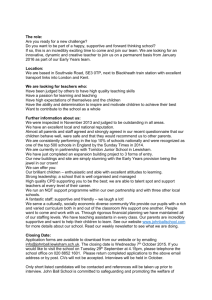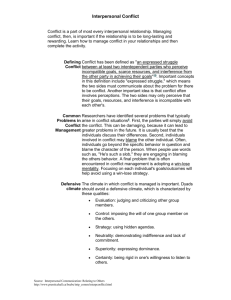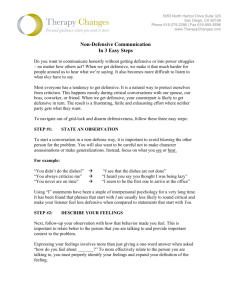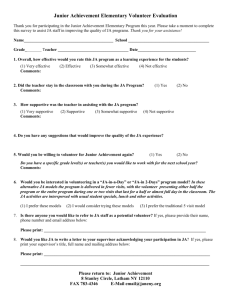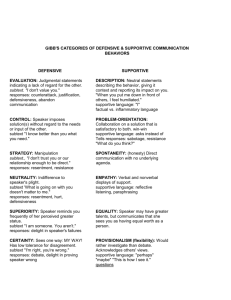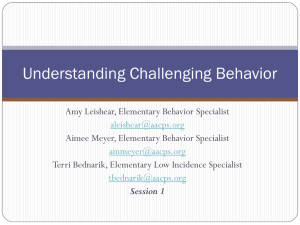Full Text - Life Science Journal
advertisement
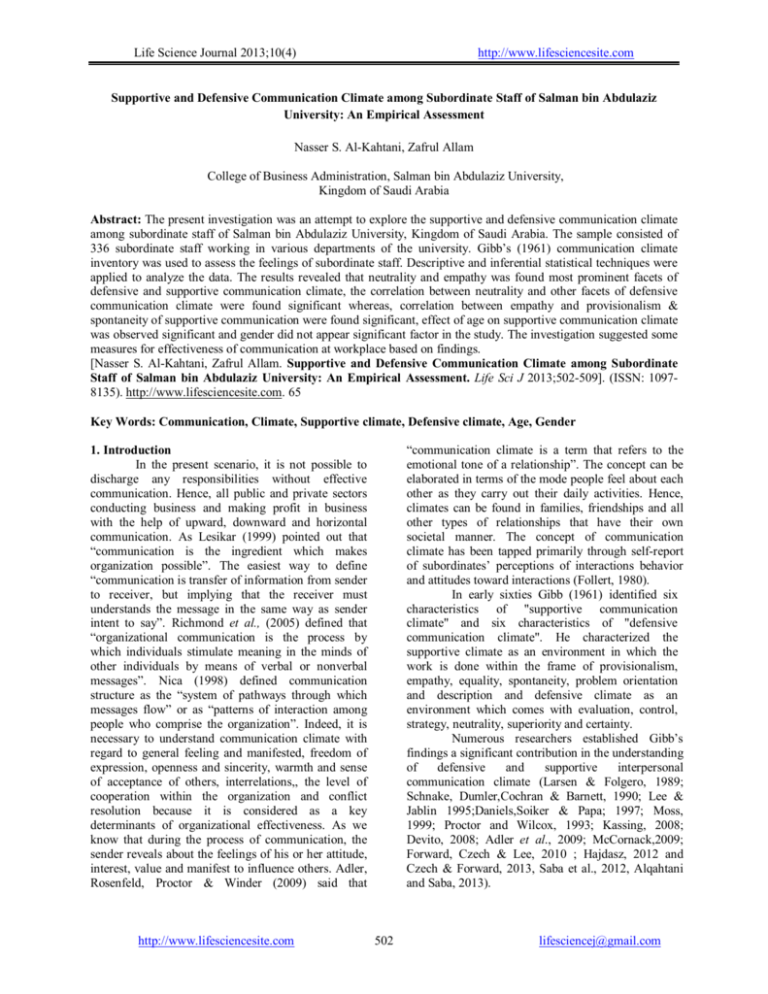
Life Science Journal 2013;10(4) http://www.lifesciencesite.com Supportive and Defensive Communication Climate among Subordinate Staff of Salman bin Abdulaziz University: An Empirical Assessment Nasser S. Al-Kahtani, Zafrul Allam College of Business Administration, Salman bin Abdulaziz University, Kingdom of Saudi Arabia Abstract: The present investigation was an attempt to explore the supportive and defensive communication climate among subordinate staff of Salman bin Abdulaziz University, Kingdom of Saudi Arabia. The sample consisted of 336 subordinate staff working in various departments of the university. Gibb’s (1961) communication climate inventory was used to assess the feelings of subordinate staff. Descriptive and inferential statistical techniques were applied to analyze the data. The results revealed that neutrality and empathy was found most prominent facets of defensive and supportive communication climate, the correlation between neutrality and other facets of defensive communication climate were found significant whereas, correlation between empathy and provisionalism & spontaneity of supportive communication were found significant, effect of age on supportive communication climate was observed significant and gender did not appear significant factor in the study. The investigation suggested some measures for effectiveness of communication at workplace based on findings. [Nasser S. Al-Kahtani, Zafrul Allam. Supportive and Defensive Communication Climate among Subordinate Staff of Salman bin Abdulaziz University: An Empirical Assessment. Life Sci J 2013;502-509]. (ISSN: 10978135). http://www.lifesciencesite.com. 65 Key Words: Communication, Climate, Supportive climate, Defensive climate, Age, Gender “communication climate is a term that refers to the emotional tone of a relationship”. The concept can be elaborated in terms of the mode people feel about each other as they carry out their daily activities. Hence, climates can be found in families, friendships and all other types of relationships that have their own societal manner. The concept of communication climate has been tapped primarily through self-report of subordinates’ perceptions of interactions behavior and attitudes toward interactions (Follert, 1980). In early sixties Gibb (1961) identified six characteristics of "supportive communication climate" and six characteristics of "defensive communication climate". He characterized the supportive climate as an environment in which the work is done within the frame of provisionalism, empathy, equality, spontaneity, problem orientation and description and defensive climate as an environment which comes with evaluation, control, strategy, neutrality, superiority and certainty. Numerous researchers established Gibb’s findings a significant contribution in the understanding of defensive and supportive interpersonal communication climate (Larsen & Folgero, 1989; Schnake, Dumler,Cochran & Barnett, 1990; Lee & Jablin 1995;Daniels,Soiker & Papa; 1997; Moss, 1999; Proctor and Wilcox, 1993; Kassing, 2008; Devito, 2008; Adler et al., 2009; McCornack,2009; Forward, Czech & Lee, 2010 ; Hajdasz, 2012 and Czech & Forward, 2013, Saba et al., 2012, Alqahtani and Saba, 2013). 1. Introduction In the present scenario, it is not possible to discharge any responsibilities without effective communication. Hence, all public and private sectors conducting business and making profit in business with the help of upward, downward and horizontal communication. As Lesikar (1999) pointed out that “communication is the ingredient which makes organization possible”. The easiest way to define “communication is transfer of information from sender to receiver, but implying that the receiver must understands the message in the same way as sender intent to say”. Richmond et al., (2005) defined that “organizational communication is the process by which individuals stimulate meaning in the minds of other individuals by means of verbal or nonverbal messages”. Nica (1998) defined communication structure as the “system of pathways through which messages flow” or as “patterns of interaction among people who comprise the organization”. Indeed, it is necessary to understand communication climate with regard to general feeling and manifested, freedom of expression, openness and sincerity, warmth and sense of acceptance of others, interrelations,, the level of cooperation within the organization and conflict resolution because it is considered as a key determinants of organizational effectiveness. As we know that during the process of communication, the sender reveals about the feelings of his or her attitude, interest, value and manifest to influence others. Adler, Rosenfeld, Proctor & Winder (2009) said that http://www.lifesciencesite.com 502 lifesciencej@gmail.com Life Science Journal 2013;10(4) http://www.lifesciencesite.com Pavitt (2000) observed that there is a relationship between member communication and work productivity and others supported (Clampitt & Downs, 2005; Madlock,2001 and Segumpan,1999) whereas, Fernandez (2001) pointed out that communication is not playing a key role to establish working relationship and productivity in the organization unless interventions were communicated. Various researchers found a significant relationship between climate and job satisfaction, performance, output, supervisory ratings, support, interpersonal relations and turnover (Follert, 1980; Ray, 1987; Zalesny & Ford, 1990; Bridge & Baxter, 1992; Apker, Ford and Fox, 2003; Myers and Johnson, 2004 and Madlock & Booth-Butterfield,2012) Weihrich and Koontz (1993) conducted a study and emphasized that in the process of operating an organization, communication is responsible for linking people to achieve common goals.Cheney (1995) emphasized in relation to democratic workplace and focused communicative link between participative decision making, openness, trust and supportiveness. Anene (2006) focused that the success of any organization not depends only on qualified personnel but also on the interaction between the personnel and clientele. Burleson (2009) explains the concept of supportiveness through outcomes of supportive interactions and defined as “verbal and nonverbal behavior produced with the intention of providing assistance to others perceived as needing that aid”. However, Burleson focused on the factors that impact individual’s evaluations of supportive messages in two different investigations and revealed facts that very high levels of emotional upset minimized the ability to process supportive messages. Forward, Czech and Lee (2011) initiated a study to investigate utility of Gibb’s (1961) theory of defensive and supportive communication with the help of Costigan and Schmeidler in (1984) in their inspection tool. The results concluded with certain suggestions for interpreting and reconceptualizing the communication climate construct and emphasized that one defensive and supportive action highlighted on task and another defensive and supportive action emphasized on interpersonal relationships. Hajdasz (2012) explored the Gibb’s model of supportive and defensive communication climate and results focused on factors that affect the feelings of communication climate. Further researcher focused that supportive and defensive communication leads to positive and negative communication but negative influence of defensive communication overrides the positive impact of supportive communication on the on the rise communication climate. http://www.lifesciencesite.com Glomo-Narzoles (2012) conducted a study and results highlighted that neutral emerged as one of the dominant facet of communication climate and institutional productivity was found significantly related with communication climate in school. Czech & Lee (2013) conducted a study and identified inverse association between subordinate and equality feelings of superior effectiveness. Further, their result appeared that relationship satisfaction was predicted by description and empathy. 1.1. The Goals of the Research Various researches have been conducted by the researchers in the area of supportive and defensive communication climate all over the globe but negligible studies initiated by the researchers in Kingdom of Saudi Arabia to understand the feelings of subordinates towards the supervisors in their respective work in various departments of Salman bin Abdulaziz University in relation to supportive and defensive communication climate. Therefore, following research objectives were frame: To examine supportive and defensive communication climate and their most prominent facets among subordinate staff. To explore the correlation between most prominent facets of supportive and defensive communication climate. To determine the differences between younger and older subordinates in relation to supportive and defensive communication climate. To determine the differences between male and female employees in relation to the supportive and defensive communication climate. 1.2. Hypothesis Keeping the objective of the present study and based on retrospection of research literature reviewed, certain null hypotheses were formulated and each hypothesis was verified to draw inferences on the basis of the results obtained. These hypotheses are as follows: H01: The younger and older in age group of subordinate staff would not differ in terms of defensive communication climate. H02: The younger and older in age group of subordinate staff would not differ in terms of supportive communication climate. H03: The male and female group of subordinate staff would not differ significantly in terms of defensive communication climate. H04: The male and female group of subordinate staff would not differ significantly in terms of supportive communication climate. 503 lifesciencej@gmail.com Life Science Journal 2013;10(4) http://www.lifesciencesite.com that communication climate inventory designed in such a manner that lower the score the greater extent to which either climate exists in the organization. However, low supportive scores probably is the indication that defensive scores are high and vice versa, the reason is very simple that both the climate would not exist at a same time in the organization and variance in scores will be occurred due to subject being assessed. 2.3. Statistics Used The data collected for the present study were coded and analyzed by using Microsoft Excel and SPSS 16.0 version. Descriptive and inferential test were used to analyze the data using mean, sd, correlation and t-test. The correlation was used to highlight the relationship between most prominent factors of supportive or defensive communication climate with their facets. Keeping in view the purpose of the present study and requirements of a scientific investigation t-test was also used to see the significant difference of the groups. 2.4. Procedure and ethics The total 450 questionnaires were distributed among subordinate staffs at Salman bin Abdulaziz University, Kingdom of Saudi Arabia and finally investigators received 336, it means 75% questionnaire were filled by the respondents. Initially, English version of questionnaire was translated into Arabic to make the respondents to understand each item in an effective manner with the help of experts to maintain the sanctity of the language. Clear instruction were given to these respondents and provided mobile numbers to them to call for help whenever they have doubts. The subjects were informed to take their own time to complete the questionnaires. The collected data put into statistical analyses for results. Further, it was necessary to maintain ethics of the research, certain formalities have been taken into account like permission has been taken from higher officials and assured to the respondents about the confidentiality will not revealed to any one at any circumstances and informed them that this study will be used for academic purpose. 3. Results Table-1 showed mean and sd of defensive communication climate and its dimensions among subordinate staff at Salman bin Abdulaziz University. The mean and sd of different factors such as evaluation (7.88 & 1.49), control (7.86 & 2.09), strategy (7.64 & 2.25), neutrality (7.08 & 2.35), superiority (7.77 & 1.99) and certainty (7.15 & 1.79) were observed among subordinate staff towards their superior at Salman bin Abdulaziz University. Among all the facets of defensive communication climate the neutrality was found to be lowest mean score with 2. Methods 2.1. Sample The study consisting of 336 subordinate staffs were selected randomly from different departments of Salman bin Abdulaziz University, Kingdom of Saudi Arabia. Out of total sample sixty nine percent (N=231) were less than 30 years and considered as younger employees whereas, 31 percent (N=105) were more than 30 years which been taken as an older employees. The subjects have been categories into male (N=189) and female (N=147). Thirty eight percent (N=128) of the present study reported monthly income Saudi riyals 6000 or less, fifty six percent (N=187) indicated an income between Saudi riyals 6001 to 9000 and rest of the 6 % (N=21) respondents pointed out income greater than Saudi riyals 9000.Forty one percent (N=136) subjects of the study were single, 57% (N=193) were married and remaining 2 % (N=7) were widow/widower. Additionally, 34% (N=116) reported their experiences 2 years or less, around 50% (N=167) have worked for their present supervisors between 2 to 4 years and remaining 15 % (N= 53) experienced their work between 5 to 7 years with supervisor. Diagram for biographical information: 2.2. Instrument The Communication Climate Inventory developed and standardised by Gibb (1961) was used in the study. The questionnaire consists of 36 items and each item has to be rated on a five point Likert style rating scale ranging from strongly agree to strongly disagree with a weightage score of 1 to 5.The questionnaire divided into two categories of communication climate namely defensive (odd items) and supportive (even items) types of communication climate. Gibbs pointed out that the lowest possible overall climate scores is 18 and highest scores 90 on either the defensive or supportive. Further he said http://www.lifesciencesite.com 504 lifesciencej@gmail.com Life Science Journal 2013;10(4) http://www.lifesciencesite.com highest sd whereas, evaluation is considered as highest mean scores with lowest sd which reflects towards defensive to supportive communication climate among juniors. Further, it appears very explicit from the diagram-1 which showed neutrality is the lowest mean score whereas, evaluation showed highest mean score. Table1-Showing Mean and SDs of defensive communication climate and its facets among administrative subordinate staff of Salman bin Abdulaziz University (N=336) All Facets of Defensive Climate Mean SD Evaluation 7.88 1.49 Control 7.86 2.09 Strategy 7.64 2.25 Neutrality 7.08 2.35 Superiority 7.77 1.91 Certainty 7.15 1.79 Grand Total Defensive Climate 45.38 7..94 Diagram-2 Showing Means of all Facets of Supportive Communication Climate of administrative subordinate staff of Salman bin Abdulaziz University It appears from Table-2 that mean and sd of supportive communication climate and its facets among subordinate staff at Salman bin Abdulaziz University. The mean and sd of various components of supportive communication climate such as provisionalism (8.26 & 2.02), empathy (7.31 & 1.97), equality (8.72 & 2.18), spontaneity (7.71& 2.06), problem orientation (9.14 & 2.65) and description (7.92 & 2.08) were observed among subordinate staff of Salman bin Abdulaziz University. Among all the facets of supportive communication climate the problem orientation was found to be highest mean score whereas, empathy showed lowest mean score. Moreover, the above results can be clearly observed with the help of diagram-2 that problem orientation appeared highest mean score and on the other hand empathy appeared lowest mean score. Diagram-1 Showing Means of all Facets of Defensive Communication Climate of administrative subordinate staff of Salman bin Abdulaziz University Table 3-Showing correlation of facets of defensive communication climate with neutrality of administrative subordinate staff of Salman bin Abdulaziz University (N=336) Table 2-Showing Mean and SDs of Supportive communication climate and its facets among administrative subordinate staff of Salman bin Abdulaziz University (N=336) All Facets of Supportive Climate Mean SD Provisionalism 8.26 2.02 Empathy 7.31 1.97 Equality 8.72 2.18 Spontaneity 7.71 2.06 Problem Orientation 9.14 2.65 Description 7.92 2.08 Grand Total Supportive Climate 49.06 8.09 http://www.lifesciencesite.com All Facets of Defensive Correlation Climate Neutrality Evaluation .336** Control .402** Strategy .466** Superiority .131* Certainty .497** ** Correlation is significant at the 0.01 level * Correlation is significant at the 0.05 level 505 with lifesciencej@gmail.com Life Science Journal 2013;10(4) http://www.lifesciencesite.com Table-3 highlighted the correlation of various facets of defensive communication climate with neutrality. It is observed from the results that neutrality was found to be most prominent factors out of other factors of defensive communication climate. The correlation between neutrality and other five facets of defensive communication climate were found significant. It has been observed from the Table-6 that mean value of supportive communication climate scores of younger and older employees were found 49.53 and 48.03 with SD 8.07 and 8.09 respectively. When two groups compared the difference between younger and older employees (t=2.41, p<.01) were observed significant. Hence, null hypothesis (H02) was rejected. Table 4 - Showing correlation of facets of supportive communication climate with empathy of administrative subordinate staff of Salman bin Abdulaziz University (N=336) All Facets of Supportive Correlation with Climate Empathy Provisionalism .199** Equality .011 Spontaneity .398** Problem Orientation -.084 Description .056 ** Correlation is significant at the 0.01 level Table 7-Showing Mean, SDs and t- value of defensive communication climate among male & female administrative subordinate staff of Salman bin Abdulaziz University Groups N Mean SD t Compared Male 189 45.37 7.85 .97 Female 147 45.39 8.10 Not Significant It can be seen from the Table-7 that mean defensive communication climate scores of male and female employees were 45.37 and 45.39 with SD 7.85 and 8.10 respectively and t value found to be.97 which showed the two groups of employees did not differ significantly. Therefore, null hypothesis (H03) was accepted. It is evident from Table-4 that correlation of various facets of supportive communication climate with empathy which has been emerged as the most prominent factors out of other factors of supportive communication climate. The correlation between empathy and provisionalism & spontaneity were found significant whereas, other factor did not show significant relationship. Table 8-Showing Mean, SDs and t- value of supportive communication climate among male & female administrative subordinate staff of Salman bin Abdulaziz University Groups Compared N Mean SD t Male 189 48.65 7.99 .29 Female 147 49.59 8.22 Not Significant Table 5-Showing Mean, SDs and t-value of defensive communication climate among younger and older administrative subordinate staff of Salman bin Abdulaziz University Groups compared N Mean SD t Younger 231 45.54 8.25 Older 105 45.03 7.26 .86 Not Significant It is evident from the Table-8 that mean value of supportive communication climate scores of male and female employees were found 48.65 and 49.59 with SD 7.99 and 8.22 respectively. Further t value was found to be.29 which indicates that two groups of employees did not differ significantly. Hence, null hypothesis (H04) was not rejected. It is observed from the Table-5 that mean defensive communication climate scores of younger and older employees were 45.54 and 45.03 with SD 8.25 and 7.26 respectively and t value found.86 which showed the two groups of employees did not differ significantly. Therefore, null hypothesis (H01) was not rejected. 4. Discussion The result obtained from Table -1 and diagram-1 clearly indicated that neutrality was found to be lowest mean score with highest sd whereas, evaluation is considered as highest mean scores with lowest sd which reflects feelings of subordinate staff towards defensive to supportive communication climate. This finding has been highlighted by GlomoNarzoles (2012) and Redding (1985). However, this could be due to certain factors that supervisor provides minimal support to the juniors and keeping himself/herself away to resolve the personal and Table 6-Showing Mean, SDs and t-value of supportive communication climate among younger and older administrative subordinate staff of Salman bin Abdulaziz University Groups compared N Mean SD t Younger 231 49.53.54 8.07 Older 105 48.03 8.09 2.41* *Significant at.01 level http://www.lifesciencesite.com 506 lifesciencej@gmail.com Life Science Journal 2013;10(4) http://www.lifesciencesite.com professional problem in the work. Further, supervisor criticizes for their work to improve the performance at work. In the light of obtained result (Ref.Table-2 and Diagram-2), it has been seen that among all the facets of supportive communication climate the problem orientation was found to be highest mean score whereas, empathy showed lowest mean score. As a remainder, low supportive scores probably is the indication that defensive scores are high and vice versa. This can be discussed in the light of literature available that value, opinions, feelings and problem of employees must be taken into account to make the work environment more supportive. Whenever, anyone in the organization faces problems, it should be rectify and provide suggestions and training as per their needs. This finding has been supported by Cheney (1995) and Hajdasz (2012). Table-3 highlighted that correlation of various facets of defensive communication climate with neutrality. It is observed from the results that neutrality was found to be most prominent factors out of other factors of defensive communication climate. It can be highlighted that juniors feelings against supervisor are defensive and not providing moral and social support and at the time of crisis and showing lack of concern for their subordinates. However, empathy emerged as the most prominent factors out of other factors of supportive communication climate (Ref.Table-4).The correlation between empathy and provisionalism & spontaneity were found significant whereas, other factor did not show significant relationship. The result might be interpreted that supervisor used to address the value, opinion and goal of the juniors. Further, supervisor also allows their juniors to express their feeling freely without any fear and encourages for their creative works. Pace and Faules (1994) also supported the finding. Result obtained from the Table-5 that mean defensive communication climate scores of younger and older employees and showed the two groups of employees did not differ significantly. It can be infer from the results that younger subjects having less experience and knowledge about the work culture or climate. Hence, they need more supportive climate to exercise their duties. In contrast, older employees having more experiences and they know right or wrong. Hence, manager should provide passage to discharge the responsibilities of the organization rather to control and evaluate. In the light of result obtained from the Table-6 that two groups of younger and older employees differ significantly as far as supportive communication climate is concerned. The result might be interpreted that Salman bin Abdulaziz University is growing university in the Kingdom of http://www.lifesciencesite.com Saudi Arabia and future growth for junior employees are high. Younger employees, who just started their occupation to work in the university most probably, require to be more controlled due to their lack of experience and thus need supervision and assistance to discharge the responsibilities for future growth. In contrast, older employees having more experiences and they know pros and cons of all the accomplishment of work done and hence showed less supportive communication climate. Result obtained from Table-7 and Table-8 that male and female (t-test) showed that there were no differences between them in defensive and supportive communication climate. The result might be interpreted that Kingdom of Saudi Arabia is considered an Islamic country and hence male and female are not working together but they have opportunities to work in the same set up with same gender. However, Salman bin Abdulaziz University also follows the same value and legitimate requirement of the nation and have segregation of gender at work. Holmstrom (2009) discussed that the communication values of gender i.e. men and women based on whom they are interacting with, whether it is someone of the same or the opposite gender. In the present study the supervisor of female employees is same gender and hence it is easy to control and evaluate their actions. However, male can easily criticize their junior and control their role at work. Sullivan (2004) emphasized that there are significant differences between the genders as it is not identified in the study. 5. Conclusions The following conclusions were drawn from the findings: Among all the facets of defensive communication climate the neutrality was found most prominent facet and evaluation is emerged as least in defensive communication climate. Empathy emerged as a prominent facet of supportive communication climate whereas, problem orientation was found to be least in the climate. Supportive communication climate is identified most prominent climate compared to defensive communication climate by the subordinate staff at the Salman bin Abdulaziz University. The correlation between neutrality and other facets of defensive communication climate were found significant. The correlation between empathy and provisionalism & spontaneity were found significant whereas, other factor did not 507 lifesciencej@gmail.com Life Science Journal 2013;10(4) http://www.lifesciencesite.com show significant relationship in supportive communication climate. Younger employees showed higher level of feelings in terms of defensive communication climate but found significantly more supportive communication climate compared to older employees Female employees showed higher level of feelings in terms of defensive and supportive communication climate and not differ significantly. [4] [5] [6] [7] 6. Suggestions and limitation conflict all depends on how the supervisor treated and communicated with their employees. In addition, sometimes junior employees are not clear what is expected from his/her to carry and discharge the responsibilities. Hence supervisor must use supportive climate which play a pivotal role to motivate the employees and provide sufficient back up as required in the work setting. As we know that manager get things done through other people so it is the responsibilities of the supervisor to listen well and foster strong supportive communication climate to increase the job satisfaction, commitment and productivity of the organization. Like other researches in the area of social and management sciences, the present study has also certain shortcomings but has scope for future research. The sample has taken from one university and subordinate staff only working in various administrations. Hence, it is necessary to conduct with varied sample. The instrument used in the present investigation developed many years back so it will be more effective to use recently developed & standardized instruments and other statistical techniques can also be applied for better understanding of supportive and defensive communication climate. [8] [9] [10] [11] [12] [13] References [1] Adler, R., Rosenfeld, L., Proctor, R., and Winder, C. Interplay: The process of interpersonal communication (2009): Don Mills, Ontario: Oxford University Press. [2] Anene, M. Effectiveness of communication in administration ((2006):Abraka: Delta State University. [3] Apker, J., Ford, W. S. Z., and Fox, D. H. Predicting nurses’ organizational and professional identification: The effect of nursing roles, professional autonomy, and supportive communication. Nursing Economics (2003): 21, 226-232. http://www.lifesciencesite.com [14] [15] [16] [17] 508 Bridge, K. and Baxter, L. A. Blended relationships: Friends as work associates. Western Journal of Speech Communication (1992): 55, 180-197. Burleson, B. Understanding the outcomes of supportive communication: A dualprocess approach. Journal of Social & Personal Relationships (2009):26(1), 21-38. Cheney, C. Democracy in the workplace: Theory and practice from the perspective of communication. Journal of Applied Communication Research (1995):23, 167-200. Clampitt, P. and Downs. Employees perceptions of the relationship between communication and productivity. The Journal of junior Business The revelation suggests that employees’ feelings tow Communication (1993): 30, 5-28. Costigan, J., and Schmeidler, M. Exploring supportive and defensive communication climates. In J. W. Pfeiffer and L. D. Goodstein (Eds.), The 1984 annual: Developing human resources (pp. 112-118). San Diego: Pfeiffer Czech, K. and Forward, G.L. Communication, Leadership, and Job Satisfaction: Perspectives on Supervisor-Subordinate Relationships. Studies in Media and Communication, (2013):1(2), 1-24. Daniels, T. D., Spiker, B. K. and Papa, M. J. Perspectives on organizational communication, (1997): (4th ed.). Madison, WI: Brown & Benchmark. Devito, J. Interpersonal messages: Communication and relationship skills. Boston (2008): Allyn & Bacon. Alqahtani, F. A. and Saba, T. Impact of Social Networks on Customer Relation Management (CRM) in Prospectus of Business Environment, Journal of American Sciences 2013, vol.9(7), 480-486. Forward, G. L., Czech, K.. and Lee, C. M. Assessing Gibb’s supportive and defensive communication climate: An examination of measurement and construct validity. Communication Research Reports (2011): 28(1), 1-15. Gibb, J. Defensive communication. Journal of Communication (1961): 11, 141-148. Glomo-Narzoles, D. T. Communication climate: Its relation to institutional productivity. Asian Journal of Social Sciences & Humanities (2012):1(4), 196-205. Hajdasz, P. An exploratory study of the relationship between defensive and supportive talk, verbal aggressiveness and communication climate (2012): Unpublished Thesis, University of Ottawa, Canada. Holmstrom, A. J. Sex and gender similarities and differences in communication values in same-sex lifesciencej@gmail.com Life Science Journal 2013;10(4) [18] [19] [20] [21] [22] [23] [24] [25] [26] [27] [28] [29] http://www.lifesciencesite.com and cross-sex friendships. Communication Quarterly (2009): 57(2), 224-238. Kassing, J. W. Consider this: A comparison of factors contributing to employees’ expressions of dissent. Communication Quarterly (2008): 56(3), 342-355. Larsen, S. and Folgero, I. Supportive and defensive communication. International Journal of Contemporary Hospital Management (1993): 5(3), 22 – 25. Lee, J., and Jablin, F. Maintenance communication in supervisor-subordinate work relationships. Human Communication Research (1995): 22(2), 220-257. Lesikar, R.V., Pettit, J.D., and Darsey, N.S. Communication in business(1999): London: Longman. Madlock, P.The link between leadership style, communication competence, and employee satisfaction. Journal of Business Communication (2008): 45(1), 61-78. Madlock, P. E. and Booth-Butterfield, M. The Influence of Relational Maintenance Strategies Among Coworkers. Journal of Business Communication (2012):4, 21-47. McCornack, S. Reflect and relate: An introduction to interpersonal communication (2009): Boston, MA: Bedford/St. Martin’s. Moss, D. Humanistic and transpersonal psychology: A historical and biographical sourcebook (1999): Westport, CT: Greenwood Press. Pace, R, W. and Faules, D. F. Organisational communication (1994):3rd edn, Allyn & Bacon, Boston, MA. Pavitt, E. Groups Versus Individuals: Which is "Better"? Retrieved from http://www.udel.edu/ communication/ COMM356/pavitt.htm(2000). Proctor, R. F. and Wilcox, J. R. An exploratory analysis of responses to owned messages in interpersonal communication. ETC: A Review of General Semantics (1993):50(2), 201-220. Ray, E. B. Supportive relationships and occupational stress in the workplace. In T. Albrecht & M. Adelman (Eds.), Communicating [30] [31] [32] [33] [34] [35] [36] [37] [38] [39] social support (pp. 172-191). Newbury Park, CA: SAGE. (1987). Redding, W. C. Stumbling toward identity: The emergence of organizational communication as a field of study. In R. D. McPhee & P. K. Tompkins (Eds.), Organizational communication: Traditional themes and new directions (pp. 15-54). Newbury Park, CA: Sage. (1985). Richmond, V. P., McCroskey J. C. and McCroskey L. L. Organizational Communication for Survival: Making Work, Work (2005). Allyn and Bacon, Needham Heights MA Saba T, Al-Zaharani S, Rehman A. Expert System for Offline Clinical Guidelines and Treatment Life Sci J 2012;9(4):2639-26 Schnake, M. E., Dumler, M. P., Cochran, D. S. and Barnett, T. R. Effects of differences in supervisor and subordinate perceptions of supervisors communication practices. The Journal of Business Communication (1990):27(1), 37-50. Segumpan, R.G. Work Performance as Influenced by Communication Climate, Empowerment and Value Focus among University personnel (1999): Unpublished Doctor of Education (Educational Management) Dissertation, West Visayas State University, Iloilo City, Philippines. Sullivan, P. Communication differences between male and female team sport athletes. Communication Reports (2004): 17(2), 121-128. Weihrich, H. and Koontz, H. Menedžment, Zagreb: Mate (1993). Zalesny, M. D. and Ford, J. K. Extending the social information processing perspective: New links to attitudes, behaviors, and perceptions. Organizational Behavior and Human Decision Process (1990): 47, 205-246. http://www.rtsa.ro/en/files/TRAS%20%2030E%20-%209%20-%20HENER.pdf http://www.academia.edu/2352763/Communicati on_Climate_Its_Relation_to_Institutional_Produ ctivity. 9/28/2013 http://www.lifesciencesite.com 509 lifesciencej@gmail.com

